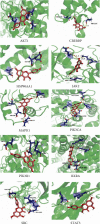Systematically Investigating the Pharmacological Mechanism of Momordica grosvenori in the Treatment of Spinal Cord Injury by Network Pharmacology and Experimental Verification
- PMID: 36743462
- PMCID: PMC9891827
- DOI: 10.1155/2023/1638966
Systematically Investigating the Pharmacological Mechanism of Momordica grosvenori in the Treatment of Spinal Cord Injury by Network Pharmacology and Experimental Verification
Abstract
Objective: This study aimed to explore the molecular mechanism of Momordica grosvenori (MG) in spinal cord injury (SCI) by network pharmacology analysis.
Methods: We searched for potential active MG compounds using the TCMSP database and the BATMAN-TCM platform. The Swiss target prediction database was used to find MG-related targets and the targets of SCI from the CTD, GeneCards, and DrugBank databases. Following that, a protein-protein interaction (PPI) study was carried out. Cytoscape software was used to calculate the hub gene, and R software was used to evaluate the Gene Ontology (GO) and KEGG enrichment pathways. Finally, molecular docking between the hub protein and important compounds was performed. We verified STAT3, MAPK1, HSP90AA1, PIK3R1, PIK3CA, and RXRA potential targets by quantitative PCR.
Results: We obtained 293 MG-anti-SCI targets with potential therapeutic utility by intersecting 346 MG-related targets and 7214 SCI-related targets. The top 10 identified genes, ranking in descending order of value, were SRC, STAT3, MAPK1, HSP90AA1, PIK3R1, PIK3CA, RXRA, AKT1, CREBBP, and JAK2. Through enrichment analysis and literature search, 10 signaling pathways were screened out. The molecular docking of important drugs and hub targets revealed that some had a higher binding affinity. The results of quantitative PCR indicated that MAPK1, RXRA, and STAT3 were expressed differently in in vitro experiments.
Conclusion: In conclusion, the current work indicated that MG might play an anti-SCI role via multicomponent, multitarget, and multichannel interaction, which presents a novel idea for further research into the precise mechanism of MG-anti-SCI interaction.
Copyright © 2023 Jiling Wang et al.
Conflict of interest statement
The authors declare no conflicts of interest.
Figures








Similar articles
-
Deciphering Pharmacological Mechanism of Buyang Huanwu Decoction for Spinal Cord Injury by Network Pharmacology Approach.Evid Based Complement Alternat Med. 2021 Apr 22;2021:9921534. doi: 10.1155/2021/9921534. eCollection 2021. Evid Based Complement Alternat Med. 2021. PMID: 33976706 Free PMC article.
-
Urolithin A as a Potential Drug for the Treatment of Spinal Cord Injuries: A Mechanistic Study Using Network Pharmacology Approaches.Evid Based Complement Alternat Med. 2022 Apr 22;2022:9090113. doi: 10.1155/2022/9090113. eCollection 2022. Evid Based Complement Alternat Med. 2022. PMID: 35497925 Free PMC article.
-
Discussion on the molecular mechanism of Duhuo Jisheng decoction in treating osteoarthritis based on network pharmacology and molecular docking.Medicine (Baltimore). 2022 Oct 21;101(42):e31009. doi: 10.1097/MD.0000000000031009. Medicine (Baltimore). 2022. PMID: 36281111 Free PMC article.
-
The mechanisms of Chuanxiong Rhizoma in treating spinal cord injury based on network pharmacology and experimental verification.Ann Transl Med. 2021 Jul;9(14):1145. doi: 10.21037/atm-21-2529. Ann Transl Med. 2021. PMID: 34430586 Free PMC article.
-
Exploration of the mechanism of Zisheng Shenqi decoction against gout arthritis using network pharmacology.Comput Biol Chem. 2021 Feb;90:107358. doi: 10.1016/j.compbiolchem.2020.107358. Epub 2020 Aug 8. Comput Biol Chem. 2021. PMID: 33243703 Review.
References
-
- Zarco Perinan M. J., Barrera Chacon J. M., Garcia Obrero I. Quality of life in patients with spinal cord injury for at least 10years: importance of secondary health complications. Rehabilitación . 2022;56(1):28–38. - PubMed
LinkOut - more resources
Full Text Sources
Miscellaneous

